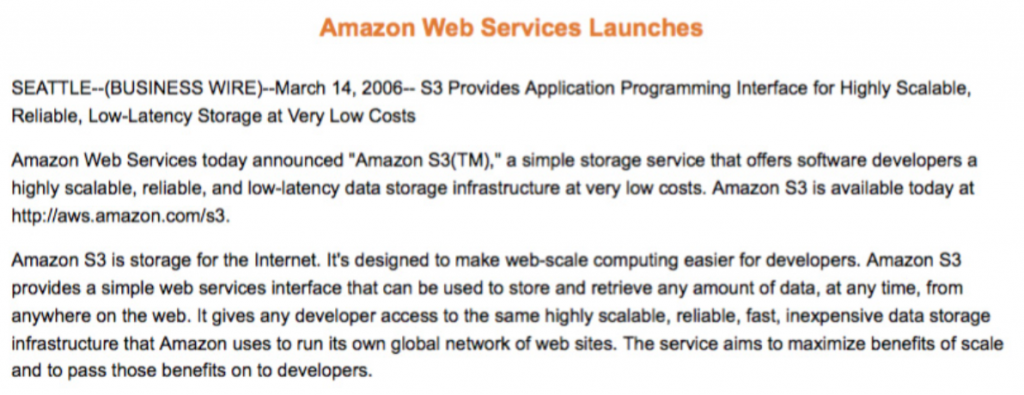Here are the 20 things I learned from reading Hiten Shah’s new (free) book 5 Habits to Building Better Products Faster:
- Figure out what your customers need, instead of what you think they need.
- The early stages of product development aren’t at all about your constraints or your resources. They’re about focusing on what’s important: the customer.
- Work backwards like Amazon. New initiatives start out by writing an internal press release. More details here. Take the example of the press release for Amazon AWS (now a $9.6 billion run rate business):

Writing this took the current head of AWS, Andy Jassy, 31 drafts before he took this to Jeff Bezos - The jobs-to-be-done formula is:
When_______, I want to _______, so I can ______.
Check out what Intercom has written about the JTBD framework.
Intercom’s example: When I talk to customers, I want to start conversations with the right customers at the right time, so I can get quality customer feedback.
JTBD makes the customer the compass that drives the direction of your product development. - “Employee motivation should be aligned with happy customers” – Chris Savage, Wistia CEO
- “Complex ideas are almost always a sign of muddled thinking or a made up problem.”—Sam Altman, Y Combinator
- One of the most important habits for continuous learning and improvement: writing stuff down.
Documentation is often more a medium of self-discipline than a way to communicate information. -> better quality thinking
Documentation is a reusable asset, and one that accrues in value and in quantity over timeBut I'm wondering... isn't there such a thing as death by documentation? Documentation overload? Too much documentation, so that the workplace becomes a big swamp, where it's impossible to move fast because you gotta wade through all that documentation?
- “The simple and familiar hold the secrets of the complex and unknown. The depth with which you master the basics influences how well you understand everything after that.” —Edward Burger and Michael Starbird, 5 Elements of Effective Thinking
Start by thinking deeply about the basics, instead of everything that you’re hoping to achieve.
Thinking deeply isn’t about increasing complexity. It’s about breaking problems down to their most basic form. Reduce the number of steps. - Tony Fadell, who led Apple’s iPod team, spent six weeks in stealth mode looking at the competition.
- Otellini’s decision [to say no to Steve Jobs when asked to build a new processor for the first iPhone] was completely logical and also completely wrong.
Without context and a larger vision for the future, data means nothing. - Summarize findings into a single sentence. This forces you to look away from the numbers, and into what they actually mean for your product.
- Before you get started on an initiative, answer the following question: What would success look like?

- Use data to constantly challenge your assumptions, to validate hypotheses, and to solve urgent problems.
- The only advantage a startup has over larger companies is the ability to move quickly.
Your competitive advantage comes from your ability to attack one problem at a time. Why? - Former HubSpot VP of Growth, Brian Balfour, gives a 4-step process for building focus:
1. Identify one long-term meaningful goal: This might mean boosting the single metric we discussed in the last chapter. The alternative to focusing on one goal that matters is to spread yourself thin on short-term optimizations in order to hedge your bets.
2. Distill the most important thing to make progress toward that goal. Say that tour goal is to increase inside sales revenue by 40%. Using data has shown you that users integrating other services increases free trial conversions by 3x. You could then focus on getting these trial users on a call with a sales rep.
3. Create a timeline for making progress long enough to gather data. All product initiatives need to have a clear goal, a measuring stick for what success looks like, and enough time to measure. For small teams, this should range from 30-60 days. Sticking to a timeline ensures that you don’t sink too many resources into a product goal that you can’t achieve. It allows you to move on and focus on the next thing.
4. Editing your longer-term goal according to data. The fourth step is why it’s so important to set a single measurable goal in the rst place. It’s what allows you to gure out what you’re doing right and wrong, and improve. Making mistakes is forgivable and inevitable in product, but failing to learn from them is wasteful. Startups operate under conditions of extreme uncertainty, and it’s tempting to
- Focus + Sequence = Speed
- Project management spreadsheet Hiten loves: click here
- A small improvement to a high-impact feature is far more important than a large improvement to a low-impact feature.
- Every day, ask yourself one question: “Am I working on the right thing, right now?”
I’d highly recommend you get yourself a free copy of the book and study it. Plus, you can even get a free consultation from him, which is freaking insane.


